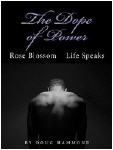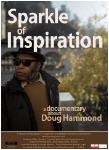Doug Hammond is one of the important multi-faceted artists – drummer, composer/arranger/conductor, ensemble leader, freelancer, educator, mentor, community-oriented stalwart -- who personify and sustain the international jazz culture. His music delivers everything that status suggests. Rose, his 13th album as a leader, is a live recording of his tentet performing his "Acknowledgement Suite," which Hammond describes as a form of thanks to "some of the people who made a great difference in my life." It portrays and repays at least some of the valuable influences those people had on him.
Rhythmically propulsive, with distinctively original melodies and unusual charts that launch imaginative improvisation from top notch collaborators, Rose is the result of a commission Hammond received from the city of Linz, which was the cultural capital of the European Union in 2009. The "Acknowledgement Suite" was composed in 2008. Hammond taught in Linz, at Bruckner University, until his retirement in 2008, and his commission funded him to put on five concerts, three of which were in Austria, one in Germany and one in the Czech Republic.
This recording of "The Acknowledgment Suite" is from the Hammond tentet's appearance at the 24th annual INNtöne Festival in Diersbach, Austria (about an hour on train from Linz). Directed by trombonist Paul Zauner, who also organized the other performances for Hammond, the fest is a cross-genre affair which has, over the decades, drawn an audience of regulars for its laid-back, quality-first presentation style. It's held on his family's working pig farm, typically for a capacity audience of about 800 people who fill up a two-level converted barn. The crowd's enthusiastic applause is heard after every track of Rose, and its receptivity without doubt inspired Hammond's ensemble, which exhibits unusual cohesion in realizing repertoire that's brand new.
Each band member also brings personal creativity to their interpretations of Hammond's pieces, which are all marked by the legacy of the 20th century African-American idiom yet also retain their composer's individuality. Hammond has a sound of his own. Working mostly within conventional song forms, he nonetheless pushes the conventions into new shapes that accommodate Western European harmonic advances as well as the swinging, bluesy feel that is fundamental to everything he plays, or writes for others.
Indeed, Hammond's compositions promote his bandmembers' individuality as much as his own. From Wendell Harrison's initial clarinet solo on the bouncy but also sly "Zeek" (named for saxophonist Ernest "Zeek" Vann, who was one of Hammond's counselors during his high school-and-after years in Tampa, Florida), through Dick Griffin's burry trombone statement that follows it, then to Kirk Lightsey's fleet choruses and thereafter to all the rest of the suite's parts, everyone does more than merely follow the conductor's lead. They must, even if not soloing, just to keep on top of the multiple threads Hammond weaves through his charts for the group. There's an Ellingtonian symbiosis at work here: The composer takes advantages of the players' personal strengths, and the players bring the fullness of those strengths to the ensemble totality.
Griffin's growl and lugubrious smears on "Ernie Cal" imbue specific drama into a mid-tempo tune that has basic rhythm 'n' blues connotations and New Orleans-referent episodes of collective improvisation. On this track, Hammond remembers tenor saxman Ernest Calhoun, "a great balladeer with a big and wonderful sound." Dwight Adams takes over on muted trumpet, citing the same vocalisms Griffin employs, but giving them his own twists; tenor saxophonist Jean Toussaint adds his deep, deliberate voice, too.
"Steppin'," written for Fletcher Davis, Hammond's "best teacher and trainer in jazz and protocol," is kicked off by Howard Curtis, to whom Hammond assigned drumming duties in the tentet so he would be free to direct from in front of it. Then the strands of the tune unfold to reveal a multi-layered design. They withdraw long enough to allow bassist Aaron James to demonstrate his excellent walk, and are reasserted at moments under Toussaint's outpouring; Adams' open horn foray is supported almost exclusively by the piano-bass-drums team, but the whole band again unfurls in full glory after Lightsey has his say.
"Rose; Sister," for Hammond's mother, is perhaps the most Ellingtonian composition here, and a palpably tender one. The son recalls that "everyone called her 'sister,' because she was always helpful to all," but when, at age 35, he began calling her "Mama," she liked that. Harrison's clarinet and Filiu's alto are posed back to back like close siblings, and Lightsey expresses his lyrical complexity with exquisite touch.
Of course Hammond does pick up his sticks on "It's Now," as this piece honors Lester McCray, his first drum teacher, and also Bill Brown, Bill Peeples, Turnip Greens and Archie Taylor, all drummers who instructed him in his approach – "to respect all paying jobs and to always do the best for the music, whatever style it might be." Dwight Adams plays masterfully, rising ever higher as the other horns riff behind him. It's also natural that Hammond would drum on "Lights," penned for his pianist Lightsey, who has been a Hammond supporter from his base in Paris, and also an organizer of a Detroit musicians' collective(In-Stage) – the kind of organization Hammond most admires.
Similar kudos attend to the great trombonist Julian Priester, in admiration of whom Hammond wrote "Mystery's Child." The tentet is at full roar, with altoist Stéphane Payen, a Parisian, topping out his solo. Roman Filiu, who’s Cuban, takes all the alto solos in "The Acknowledgement Suite" except on "Lights" and “Mystery’s Child.” The way these younger altoists bond musically with the American veterans proves once again how jazz has become a global music, a common tongue.
Hammond has led, but not documented, his creations for as large a band as this before. He is irrevocably connected to America, his native land – and visited New York City, Tampa and Detroit during the composition of "The Acknowledgement Suite" because, as he says, "I needed the reality of the atmosphere." But he's done his contemporary "classical" compositions with European professional and student musicians. He sees no contradiction, he embraces it all.
"I play with whomever is serious, in whatever style of music," Doug Hammond says. "I consider it all my heritage. I could never choose sides, and my work has reflected that so much that I've had to become a bandleader to survive. That remains my position today. Music is my life, and without it life would not have been so interesting." At age 70, he looks back without regret, at the present with a sense of achievement and at the future with ambition and optimism. Possessed of such attitudes, his "Acknowledgement Suite" is the most appropriate project for Doug Hammond to have endeavored and accomplished. His mentors would be proud, as would be his mother, Rose.© 2012
|
 |
|





